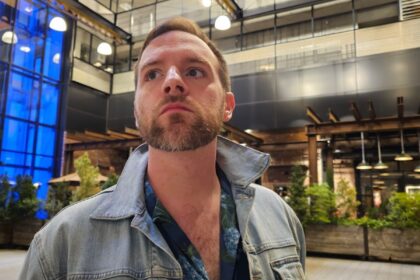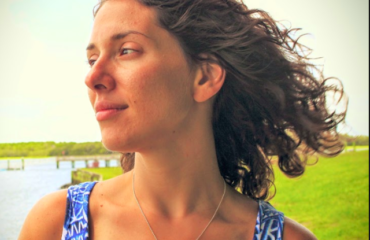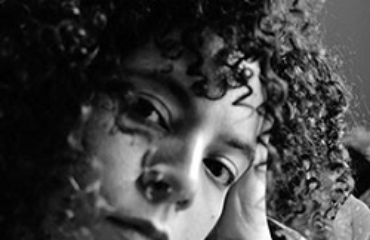INTERVIEW WITH Alexander Duringer

Alexander Duringer is from Buffalo, NY and earned his MFA in Poetry from North Carolina State University. He is a winner of the American Academy of Poets Prize as well as the Bruce & Marjorie Petesch Award. In 2022 he was a finalist for The Sewanee Review’s annual poetry contest. His poems have appeared or are forthcoming in Plainsongs, Cola Literary Review, The Seventh Wave, The Shore, and Poets.org. He is interviewed for Four Way Review by Matthew Tuckner.
FWR: I thought I would begin by asking about the role of image in your work. I often find myself thinking about the comparison of the prostate to a “little tyrant, Caligula/at war with the Tyrrhenian Sea/astride his senator horse,” or how the “curved neck of a blue heron,” in the “The Poet,” becomes a “question mark.” Considering the many startling images in these poems that are awash with the particulars of queer subjectivity, I am reminded of a quote from José Esteban Muñoz’s essay “Ephemera as Evidence” where he writes that “ephemera,” as an aesthetic mode, “is always about specificity and resisting dominant systems of aesthetic and institutional classification.” Does this definition of “ephemera” as a mode of queer image-making speak to your process in any way? How do you know when you’ve arrived at the proper expression of an image?
AD: Ah, thanks so much for such kind attention to my poems. I love this line of thinking.
Muñoz’s work is always close by as I write—particularly his thinking on utopia. Lately I’ve become interested in the ways that image—but specifically metaphor—can cascade, layer, and like a line, break into something new. I think a lot about the ways that I use metaphor/image to arrive at something that is perhaps truer than what is (at least initially) perceived? Though “true” might be the wrong word, because I think metaphors are inevitably inaccurate. I’m thinking here of a poem by Natalie Diaz called “I Watch Her Eat the Apple” where the apple held by the beloved begins as a merry-go-round spinning in her hands and ends as a bomb. The apple itself never really changes (though of course it’s consumed) but the meaning associated with it evolves from this site of childhood joy to something sinister and dangerous as it’s manipulated by the partner and observed by the speaker until the speaker herself becomes a kind of apple that will be eaten and tossed away by the beloved.
I don’t know that I was consciously thinking of Diaz when I wrote “The Prostate,” but looking at it now, I see some definite parallels. The prostate, like the apple, matters much less than the person it’s related to, and I’m interested in these shifting/varied perspectives around a subject. In many ways the prostate is an absurdity, an odd little organ that can do immense damage to a human if isn’t caught in time, but it’s also a site of pleasure and it was important to me to capture these various, conflicting, truths. It begins as a walnut and ends as something precious. It expands, it takes up space. It induces fear in men and yet it’s never really visible—it exists as a site of pure feeling. I wanted to get to this sense of affect while interrogating the ways in which this site of pleasure in the human body is often relegated to the realm of danger, something to be observed with suspicion and potentially destroyed. The image, then, is dictated by the emotional resonance around the subject matter which I think must inevitably change to arrive at the specific (to pivot back to Muńoz) vibe that the poem demands.
I’ll know that I’ve landed on the right image or image system when it resonates emotionally (and/or specifically) in the ways that I associate. “The Poet” is a violent poem and the question that the speaker refuses to ask is a violent, strange one that demands an image which will lead the reader to that since I intentionally left the question unasked. My goal with that image was to give a clue into nature of the speaker (a shift from the third-person Poet who was in control through the majority of the poem) and the question he was asking without making it completely obvious, while also highlighting the distinction between omnipotent Poet and poem’s actual speaker, who identifies more with prey than with the hunter.
The image is able to extend beyond itself into a sort of scene where the heron’s neck becomes a site of violence, moving into the shape of a question mark so that it might skewer its dinner.
FWR: I was wondering if you could talk a little bit about the ars poetic impulse in your work. These four poems all have moments that point to the poem as a tool for discovering the proper language for a certain experience. Despite the direct references to “writing” in poems like “The Poet” and “The Queer’s Epithalamium,” the other two poems also seem to gesture towards the fact of their genre implicitly. In “The Prostate,” “mouths and tongues formed new vowels.” At the end of “The night breeze so clear &,” the speaker can’t help but exclaim “Jesus christ, so many lines,” upon seeing the tangled bodies of fallen kites. How much of writing poetry for you is about working through what writing a poem actually means, what it leaves out, what it can capaciously include?
AD: This has been an essential question of the project that I started working on in my MFA and grew from many of the experiences I had there. I’m very interested in the ways that the mind works and how it works through and within things like grief and desire and fear and rage. For me this “working through” is done via writing and so I think it was inevitable that many of my poems would confront/contemplate the act of writing which, for me, is often simultaneous with thinking. The act of writing makes facets of my identity (or perhaps merely my stance) much clearer to me and yet I often feel exasperated with myself because I feel as though the only way I can approach events in my life with any authenticity is by writing, and therefore looking backward, rather than experiencing things in the present. It’s true that a poem allows me to confront, as well as interrogate my emotions with a kind of precision charged by inquiry as in “The Queer’s Epithalamium” and “The Prostate,” but I sometimes wonder if I’m losing out on opportunities in the present.
This impulse didn’t really begin until after my mother died three and a half years ago when my grief felt insurmountable and the distance that writing demands became a kind of coping. Her death spurred me into applying for an MFA after working for five years as an English teacher and in my last year teaching high school, I worked for about ten months developing a packet after ten years of writing almost nothing at all. When I got into my MFA (totally by the skin of my teeth), I was self-conscious of my stance as a writer and felt like a fraud, so I spent a lot of time learning and relearning the “basics”, which I grappled with in poems of my own. These haven’t really been seen by anyone and are largely just learning tools for myself because I process my thoughts better through writing (indeed, this very interview has helped me understand myself and my inclinations more than I had before). The work therefore became cyclical in that I wrote to learn and was learning to write. Regarding my mother’s death, I often try to create distance between myself and the subject matter, as in “night breeze” in which I recognize the impulse in myself to poeticize everything and feel frustrated by it. Thinking in this way helps me consider these events without going crazy with grief, but it’s totally a form of disassociation and sometimes I’d like to allow myself to lose control.
In my MFA, I often felt inclined to write things that felt morally questionable for me later (for example, I wrote image after image about my mother’s death bed and corpse, specifically her mouth) and one of the projects I set for myself was to grapple with and problematize those inclinations. I regret and reject these drafts now and wouldn’t ever try to publish them, but I needed to work through those things to better understand what I think is and isn’t acceptable in a poem of my own. During this same period, I was reading poems that made me deeply uncomfortable from a political and ethical standpoint. Without going into too much detail, they seemed interested mostly in shocking for the sake of it and were often violent toward targeted groups of people without considering the stakes of that violence. I usually wrote pointed responses that (despite my anger and frustration) helped me to develop a sort of rubric for my own about what was and wasn’t acceptable in a poem, at least one that was written by me. This led to “The Poet”, which is meant to confront these violent inclinations of my own and others from the perspective of a speaker who is essentially without control over his own body.
FWR: In her poem “Celestial Music,” the late Louise Glück writes that “the love of form is a love of endings.” I know, from our previous conversations, that the sonnet crown is of a particular interest to you in your writing practice. Thinking now of Glück’s assertion, it occurs to me that the sonnet crown hinges on “endings” as both destinations and beginnings–continual closings and openings. What does the sonnet, as a form, afford you as a writer? Does Glück’s equating of form with finality gel with your own feelings about form?
AD: The true sonnet crown with the fifteenth master sonnet made up of the fourteen preceding first lines embodies both beginnings and endings and I’ve always thought of the crown as a kind of ouroboros—the snake eating its own tail. It’s a closed circle, sure, but one that continues forever. One way I like to think of the sonnet as a unit (and this isn’t unique to me, of course) is that of a box. The box has to close and the poem must end, but the knowledge of that imminence fills the space with a kind of desperate charge that is tempered by the writer’s control. And when I sit down to write [a sonnet], I’m inevitably thinking about how to get to that point of closure, but honestly I’m drawn much more to the site of rupture embodied by the volta, which makes the box sizzle at its edges from this potential for change.
An important function of the sonnet for me is what Carl Phillips has described as its “capacity for innovation.” He describes this via innovations of form as well as content. A queer writer queers the sonnet by writing about queer experiences, but he can also do this via disruption of form, which I obviously did in “The Queer’s Epithalamium” [and] which is an intentionally failed sonnet. It’s only thirteen lines and two of them appear to be sliced in half. When I wrote it, I was thinking a lot about marriage and the arbitrariness of the rules we impose on ourselves, and I wanted to resist that. It’s probably a bit obvious, but I thought the sonnet—in this instance—with all its understood conventions complimented the normative wedding of the speaker’s friend. I became interested in using the broken/failed sonnet as a kind of structural representation of the cracks in the wedding’s façade, which amplify line by line beginning with the first image of the “broken swan’s neck” and ends with [the] ambiguous final line. But again, the poem’s volta is the true darling of the piece, so much so that I gave this one two: the first, where it’s conventionally meant to occur with the shift to the invocation of the speaker’s boyfriend and the second (what I think of as the ‘true’ volta), at the word “faggot”, which is meant to create a sense of whiplash in the reader as the subtextual violence queer people are made to endure at these kinds of events is dragged to the forefront. For the poem then to end a line early might imply a desire for finality or closure, but my true goal there was to try and live in the volta. The poem ends on a period, but it could just as much end on a dash (and actually, maybe it should) and leave the reader with even less closure than it currently does.
FWR: Lastly, I’d love to hear a little bit about your writing process, both generally and specifically in terms of these four poems. Do you remember the drafting process of these poems? How did they arrive at their final forms?
AD: My writing process is pretty scattered. Often I’ll begin with a project in mind—whether it’s a group of poems like a sonnet crown or an idea for an individual poem. Much of my poems are based (at least initially) in memory so I’ll try to get my thoughts on/from a specific event onto the page. This phase is very diaristic but gives me a foundation to work from as I start to lineate and make things weird. This is a frustrating process because the results always look like failure and the poems are usually eventually placed into a large document with its siblings. When I go back to that document I’ll try to move lines around from one to another and make them cannibalize each other.
This is nodded toward in “The Poet” which, as you mentioned in an earlier question, is very much an ars poetica centered around my frustrations with this process. That poem began as a much shorter piece with a different title and different beginning and was nowhere near complete. I might have showed it to three people who were like, “uh-huh,” and then I left it alone for a year or so in that large document. Then I began to work on a series (also failed, also tucked away) of poems about Antinous (the famously drowned/sacrificed paramour of the Roman emperor Hadrian). I was interested in the idea of control in relation to this young man whose life, I was arguing, was lived in service to the epitome of power and only achieved control over his own life in death, but there I was playing with him like a kind of doll. It made me uncomfortable and I could tell that the project wasn’t working, so I started moving things around. Some lines from this Antinous poem merged with lines from the earlier one and became an early draft of “The Poet”, which is much more about myself and the frustrations I feel while writing.
“The Prostate” and “The night breeze” are kind of unique for me in that they haven’t changed a whole lot since I first wrote them. Or at least nothing very dramatic has happened to their language/shapes. The latter is one of the few poems I’ve written that I don’t think has ever changed beyond a word or two. I’d been awake at night in Raleigh thinking about my parents and it just sort of happened that I reached for my computer and got to work. I might have moved some things around, but overall, it really was a kind of one-and-done poem. I wish that happened more often for me.
I’ll often change where lines are broken in “The Prostate” because I can never agree with myself on what works better. I’m so happy that that one’s been picked up by Four Way so that I can stop tinkering with it for a bit. One large edit I remember making in the tenth draft or so involved the positionality of the speaker at the end. He was originally dominant with his lover and that became frustrating for me since the poem is so much about admitting to vulnerability. I felt like this speaker needed to be the one whose body was vulnerable to demonstrate the changes that have occurred within his mind. It made the poem less about the titular organ and more about the speaker’s understanding of himself.







